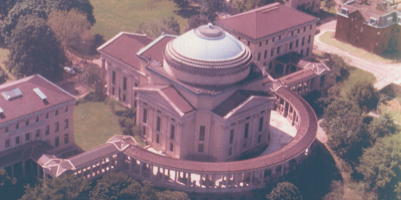Call # LD3885.H3 A5

The Hall of Fame for Great Americans collection consists of over 84 linear feet of photographs and documents related to the selection, election, and media coverage of individuals represented in the Hall of Fame located at Bronx Community College (BCC). Honorees include authors, educators, architects, inventors, military leaders, judges, theologians, philanthropists, humanitarians, scientists, statesmen, artists, musicians, actors, and explorers. Dating from the 1920s to the 1970s, the collection includes memoranda and personal correspondence, office records, publicity materials, and photographs.
In the late 1800s New York University (NYU) sought to relocate its expanding campus away from the growing congestion of Washington Square for the more pastoral locale of what is now the University Heights neighborhood of the Bronx. Largely made possible by financial backing from Mrs. Finley J. Shepard (Helen Gould), construction of the new campus was spearheaded by Dr. Henry Mitchell MacCracken, Chancellor of NYU from 1891 to 1910. This construction included the Gould Memorial Library at the heart of the University’s new campus and its adjacent open-air Colonnade, which shortly became the site of the Hall of Fame. Founded in 1900, The Hall of Fame was the first memorial of its kind in the country, built to honor prominent Americans with a significant impact on this nation’s history. Designed by renowned architect Stanford White and formally dedicated on May 30, 1901, the Colonnade accommodates 102 sculptured works and currently houses the busts and commemorative plaques of 98 of the 102 honorees inducted since 1901. In 1973, the Hall of Fame, along with the rest of the University Heights campus, was sold to the City University of New York (CUNY) and was designated the new home for BCC.
The Hall of Fame’s 98 portrait busts have been called “the largest and finest collection of bronze busts anywhere in our country.” With its rich history and unrivaled architecture, the Hall of Fame celebrates the educational accomplishments of American luminaries such as Alexander Graham Bell, George Washington Carver, Edgar Allan Poe, Ralph Waldo Emerson, Ulysses Grant, Jane Addams, Lillian Wald, Booker T. Washington, and James Madison, as well as now-forgotten statesmen, authors, and inventors. As of August 2017 the busts of Robert E. Lee and Thomas Jonathon “Stonewall” Jackson were removed from the colonnade and stored on campus.

Memory and commemoration.
This collection has a strong inclination towards documenting the commemoration of innovative thinkers and heroes in the fields of social reform and political advocacy in the United States. The Hall of Fame was a monument created specifically to celebrate public service and achievement for the common good, the basis for many American social movements, with a particularly strong emphasis in honoring educators, humanitarians, statesmen, social reformers and activists-leaders in their fields. They include New York greats such as Theodore Roosevelt, president and statesman who regulated big business and spearheaded the conservation movement; Francis Elizabeth Willard, educator, reformer, feminist, advocate of women’s suffrage; Walt Whitman, poet of democracy and editor of the Brooklyn Eagle; Emma Willard, promoter of equal education and higher education for women; and Peter Cooper, builder of the first American locomotive, steel industry pioneer, and founder of Cooper Union.
Social, economic and political upheaval of the 1970s.
Additionally, there is a great deal of documentation about the Hall that is about its construction and its relationship to the community in the collection, particularly about public programming at the Hall of Fame that took place after BCC took over the campus in 1973. The campus, including the Hall of Fame, has played a significant part in the history of the University Heights neighborhood through such public programming and events, which is also documented in the collection. The papers in this collection also highlight the political and social turmoil that brought about the sale by NYU of the University Heights campus, and consequently the Hall of Fame, whose stewardship suffered during the tumultuous financial crisis of 1970s New York City. This switch of management of the Hall between NYU and CUNY, and the City and State politicians whose calls for decreased public funding for the Hall’s upkeep contributed to its fall and disrepair in the 1980s until its resurgence in the late 1990s, are captured in the correspondence and clippings that were collected by the Hall’s administrators in the latter half of the 1970s. This theme of public disinvestment in light of the 1970s financial crisis and its effects on public sites of commemoration, combined with the move of BCC to the site and its ties to CUNY, whose mission has stood at the forefront of the quintessential American ideal of publicly accessible higher education for all, regardless of class, race, gender, or ethnicity, make for a rich archive of primary resources that capture the political and social tensions of this turbulent era.
For access, please set up an appointment with the Head Archivist, Cynthia Tobar at Cynthia.Tobar@bcc.cuny.edu




